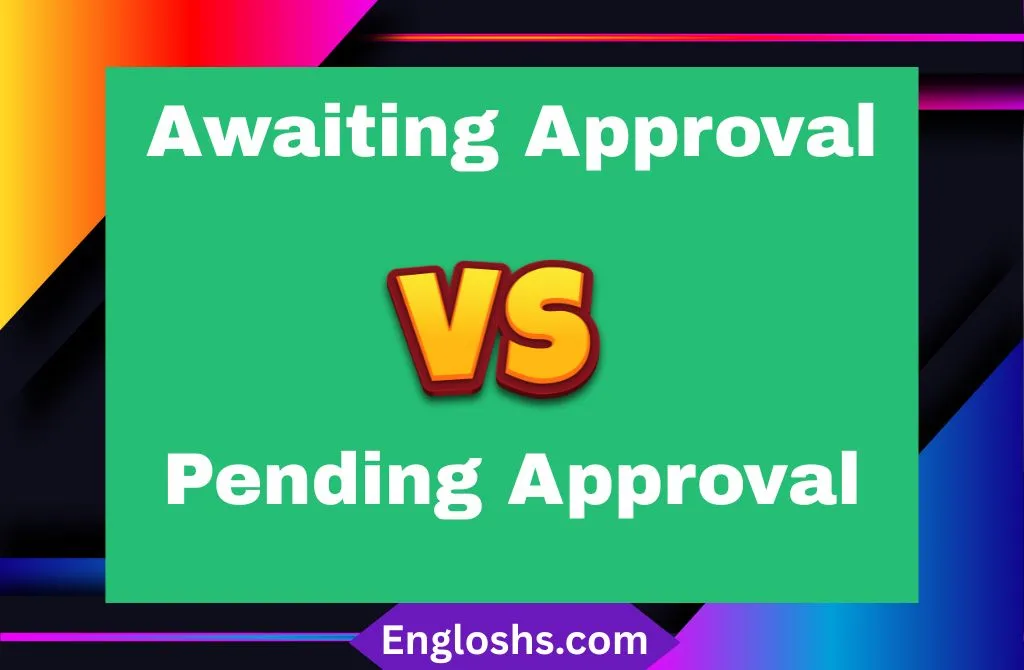When you see the phrases awaiting approval and pending approval, you might wonder if they mean the same thing or if one is more correct than the other.
Both are widely used in business, legal, and everyday communication. But subtle differences in meaning, tone, and usage can change the way your message comes across.
This article breaks down these phrases to help you choose the right one confidently.
Wondering whether to say “awaiting approval” or “pending approval”? Both are correct, but awaiting approval emphasizes actively waiting for a decision, while pending approval focuses on the current status of a process. Choose based on tone and context for clearer communication.
Understanding the Context of Approval in Language
Approval is a formal agreement or permission to proceed with a plan, document, or decision. The way we talk about approval can influence clarity, tone, and professionalism.
- Awaiting approval often emphasizes the state of waiting for someone’s explicit go-ahead.
- Pending approval highlights the process or status of something that requires approval before moving forward.
Understanding the context helps avoid miscommunication, especially in corporate or legal settings where precision matters.
The Nuances of ‘Awaiting Approval’
Awaiting means “waiting for.” When paired with approval, it implies a clear expectation that the approval will come, but it hasn’t happened yet.
- It focuses on the time delay before a decision.
- It carries a slightly more formal and active tone.
- Implies that someone or something is consciously waiting for approval.
Example:
- “The contract is awaiting approval from the legal team.”
- “Your application is currently awaiting approval.”
Examples Where ‘Awaiting Approval’ Fits Best
This phrase works well when you want to stress the waiting period for a specific person or department to give a decision.
- Project proposals
- Budget requests
- Job applications
- Legal document reviews
Example sentences:
- “The marketing budget is awaiting approval from the CFO.”
- “All expense reports are awaiting approval by the finance department.”
Variances in the Phrase ‘Awaiting Approval’
Sometimes, people shorten the phrase or adjust it slightly, such as:
- Awaiting manager approval
- Currently awaiting approval
- Still awaiting approval
Each variation maintains the same core meaning but adjusts the tone or urgency.
Deciphering ‘Pending Approval’
Pending means “awaiting a decision or settlement.” It suggests that the approval process is underway but not complete.
- Focuses on the status or condition of the item.
- It often appears in legal, governmental, or transactional contexts.
- Can sound slightly more neutral or technical than awaiting.
Example:
- “Your permit application is pending approval.”
- “The new policy is pending approval by the board.”
Common Scenarios for Using ‘Awaiting Approval’ and ‘Pending Approval’
| Scenario | Best Phrase to Use | Why? |
|---|---|---|
| Waiting for a manager’s sign-off | Awaiting approval | Emphasizes waiting on a person or team |
| Application or request in process | Pending approval | Focuses on the status of the process |
| Legal documents or permits | Pending approval | Used commonly in legal and regulatory contexts |
| Internal company workflow | Awaiting approval | Highlights the action of waiting |
Corporate Communication and Approval Processes
In corporate settings, clear language is essential. Choosing between awaiting and pending can subtly influence perceptions of efficiency and professionalism.
- Awaiting approval can convey a proactive waiting and responsibility.
- Pending approval implies the process is ongoing but may lack personal engagement.
Consider your audience:
- Clients might appreciate the clarity of “pending approval” as it sounds formal and procedural.
- Internal teams might respond better to “awaiting approval,” which sounds more dynamic and involved.
Real-World Applications of Approval Terminology
Case Study 1: Project Management
A project dashboard might display:
- “Task A: Awaiting approval by the team lead.”
- “Budget request: Pending approval from finance.”
This division helps team members understand who needs to act and what the status means.
Case Study 2: Government Permits
Government websites often use “pending approval” for permits and applications, emphasizing that decisions are in progress, not just delayed.
Grammatical Insights on ‘Awaiting’ vs. ‘Pending’
- Awaiting is a present participle verb acting like an adjective, always requiring an object (you’re awaiting something).
- Correct: “The report is awaiting approval.”
- Incorrect: “The report is awaiting.”
- Pending functions as an adjective or preposition meaning “waiting for.” It doesn’t require an object after it because it links directly to the noun.
- Correct: “The application is pending approval.”
- Incorrect: “The application is pending to approval.”
This distinction affects sentence structure and formality.
Expert Tips on Choosing the Right Approval Phrase
- Use awaiting approval when you want to emphasize the waiting action or highlight the person or team responsible for approval.
- Use pending approval when you want to focus on the status or condition of an item in a formal or technical context.
- In email subject lines or notifications, pending approval often reads clearer and fits better due to its shorter, status-like feel.
- Be consistent within documents and communications to avoid confusing your audience.
❓ FAQs Section
1. Are “awaiting approval” and “pending approval” interchangeable?
They are similar but not always interchangeable. “Awaiting approval” emphasizes waiting for a decision, while “pending approval” highlights the status of the process.
2. When should I use “awaiting approval”?
Use it when emphasizing the action of waiting for someone’s explicit approval, often internally or when highlighting responsibility.
3. When is “pending approval” more appropriate?
Use it to indicate that approval is in progress or under review, especially in formal, legal, or external contexts.
4. Can “pending” be used without an object?
Yes. “Pending” acts as an adjective and does not require an object, e.g., “The application is pending approval.”
5. Is “awaiting” always followed by an object?
Yes. “Awaiting” requires a direct object, e.g., “The report is awaiting approval.”
6. Which phrase sounds more formal?
“Pending approval” often sounds more formal and technical, while “awaiting approval” has a slightly more active and personal tone.
Closing Thoughts on ‘Awaiting Approval’ vs. ‘Pending Approval’
Both awaiting approval and pending approval are correct, but their subtle differences can influence tone, clarity, and professionalism. Knowing when to use each phrase helps you communicate more precisely and confidently.
Next time you’re stuck between these two, ask yourself: Are you focusing on the waiting or the status? Let that guide your choice.
If you enjoyed this breakdown, share it with your colleagues or bookmark it for quick reference next time you need to clarify approval language!





